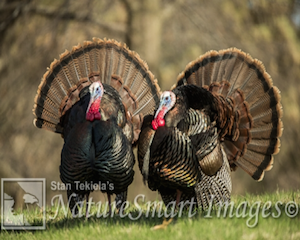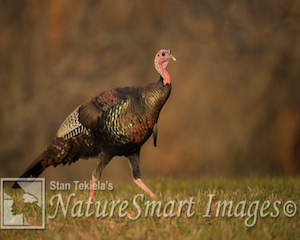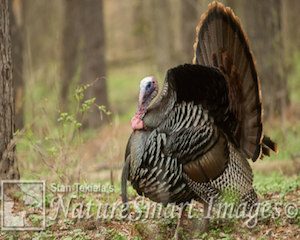
Dark Meat or Light Meat
In this week’s column, just in time for Thanksgiving, Stan Tekiela muses about dark meat or light meat.
 I’m pretty sure that when you and your family gather around the Thanksgiving table this year that you won’t spend all your time talking about birds, migration, and how those relate to the dark and light meat of the Thanksgiving turkey—but we certainly do at my house!
I’m pretty sure that when you and your family gather around the Thanksgiving table this year that you won’t spend all your time talking about birds, migration, and how those relate to the dark and light meat of the Thanksgiving turkey—but we certainly do at my house!
Ok, I will admit, it’s all my fault. I can’t help myself when someone makes an offhand comment about liking or disliking dark meat or light meat. Or someone might express an interest in having just the breast meat. When I hear this, I feel obligated to ask everyone gathered one simple question: “Do you ever wonder why turkeys have light meat and dark meat?” The answers I get are just blank stares. Of course, no one else is thinking about this. It’s probably just me who wonders about these ridiculous things.
So here is a brief explanation for you to bring up around your Thanksgiving table, in case it does come up. What we call meat, no matter if dark or light, are the bird’s muscles. Muscles are meat. All meat produces some kind of movement. There are many different kinds of movement, depending upon what the bird needs. Birds such as turkeys and chickens spend nearly all of their time walking on the ground looking and scratching around for food. They are not migratory birds. The muscles in their legs are adapted for constant use and don’t fatigue easily.
 The large leg muscles are made up of strands of red fibers that contain an abundance of fat and sugars, which are the fuel for the muscle. These muscles are also good at working with reduced oxygen requirements. These birds can walk around all day and still have enough energy and speed to run away from predators. This is the reason there is so much meat on the legs of turkeys and chickens.
The large leg muscles are made up of strands of red fibers that contain an abundance of fat and sugars, which are the fuel for the muscle. These muscles are also good at working with reduced oxygen requirements. These birds can walk around all day and still have enough energy and speed to run away from predators. This is the reason there is so much meat on the legs of turkeys and chickens.
The reason birds can fly are partially because of large breast muscles. In fact, in turkeys and chickens the breast muscle makes up 1/5th of the bird’s entire weight. In some species, such as hummingbirds, the breast muscle makes up 1/4 or 25 percent of the bird’s entire weight. It is composed of two muscles, the pectoralis (downward wing movement) and the supracoracoideus (upward wing movement) muscles. This is why the breast muscle is so bulky and thick.
Like most muscles, the breast or flight muscles act in opposite pairs or antagonistically. When one contacts the other, it relaxes and produces the fluid movement necessary for smooth wing beats. Birds such as turkeys don’t fly long distances or migrate very far. So the breast muscle is different from the long-haul leg muscles and looks different.
 The breast muscle of the turkey is adapted for short-duration, explosive bursts of power to carry it quickly away when a predator approaches. Turkeys can fly upwards of 55 miles per hour but not for long periods of time. These muscles don’t have many oils and sugars, they work mostly on oxygen, and they are light, thus they are white in appearance.
The breast muscle of the turkey is adapted for short-duration, explosive bursts of power to carry it quickly away when a predator approaches. Turkeys can fly upwards of 55 miles per hour but not for long periods of time. These muscles don’t have many oils and sugars, they work mostly on oxygen, and they are light, thus they are white in appearance.
So, armed with information, what do you think the breast meat of a migratory duck would be? Light meat or dark? Ok, I think you are getting the hang of this thing.
In nature, nothing is haphazard or “just because.” There is a reason and explanation for everything. You just need to sit down and get into the meat of it. Until next time…
If you enjoyed Stan’s post, you may consider one of his amazing nature books: Majestic Eagles; The Lives of Wolves, Coyotes, and Foxes; or Backyard Birds: Welcomed Guests at our Gardens and Feeders. Young readers will delight in his award-winning children’s books, such as Whose Butt?, Critter Litter, and his latest, Jump, Little Wood Ducks.
You can follow Stan on Facebook and Twitter, or contact him via his web page. Stan’s nationally syndicated NatureSmart Column appears in more than 25 cities spanning 5 states (Minnesota, Wisconsin, Michigan, Illinois, and Pennsylvania) and is circulated to more than 750,000 readers. Stan’s author page on Amazon features some amazing videos! Check them out, and follow him for updates.
For more stories about wildlife and nature, sign up for our newsletter now!
More posts from Stan:
Indigo Bunting—A Familiar Summer Visitor
The Nesting Behaviors of Sandhill Cranes
Big Birds, Baby Birds, Birds Everywhere
Stan Tekiela observes Marsh Wrens
The Magical, Mystical World of Sandhill Cranes


